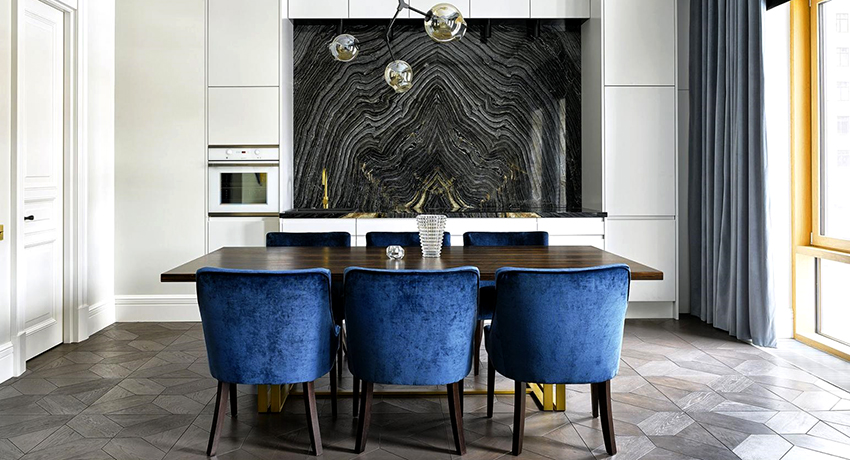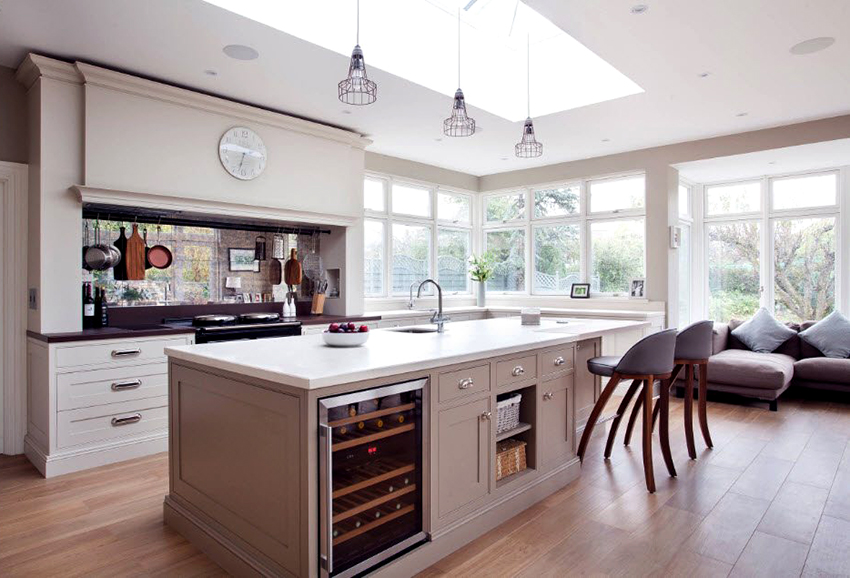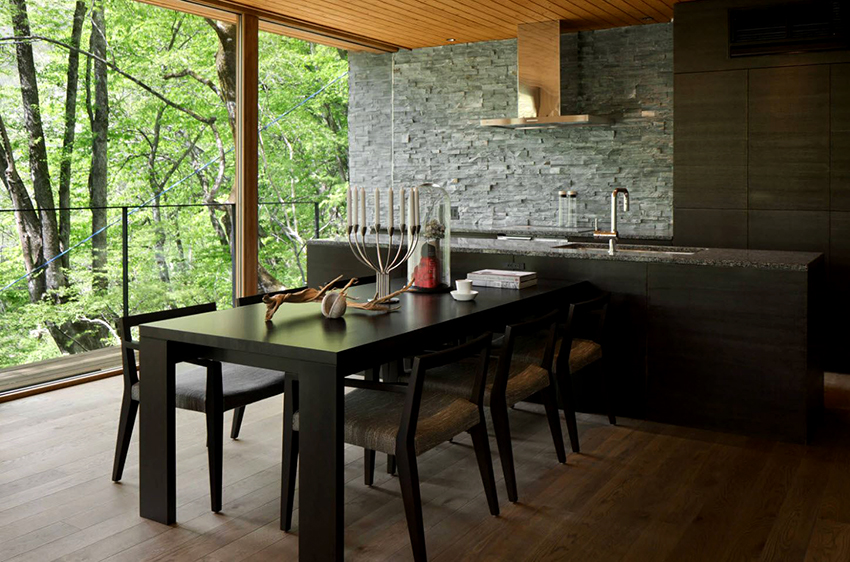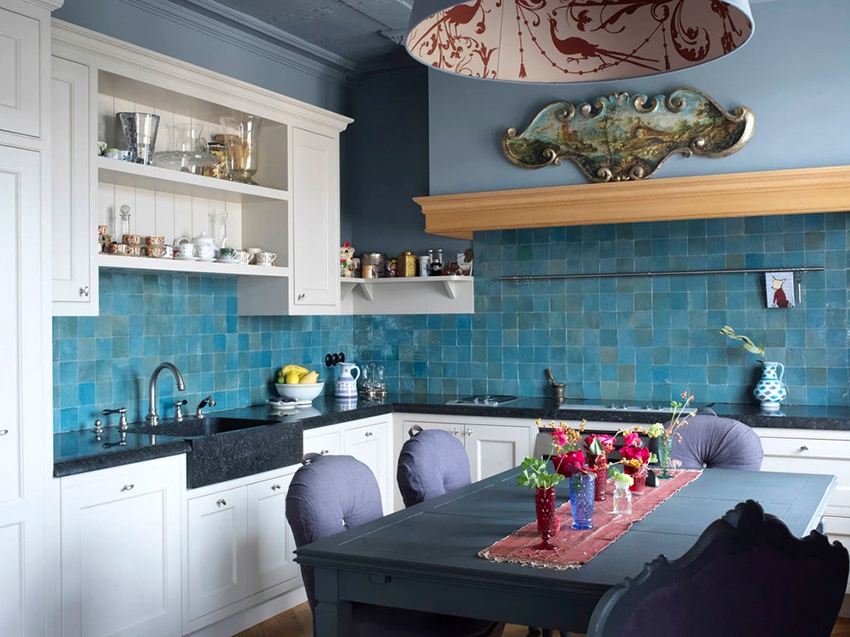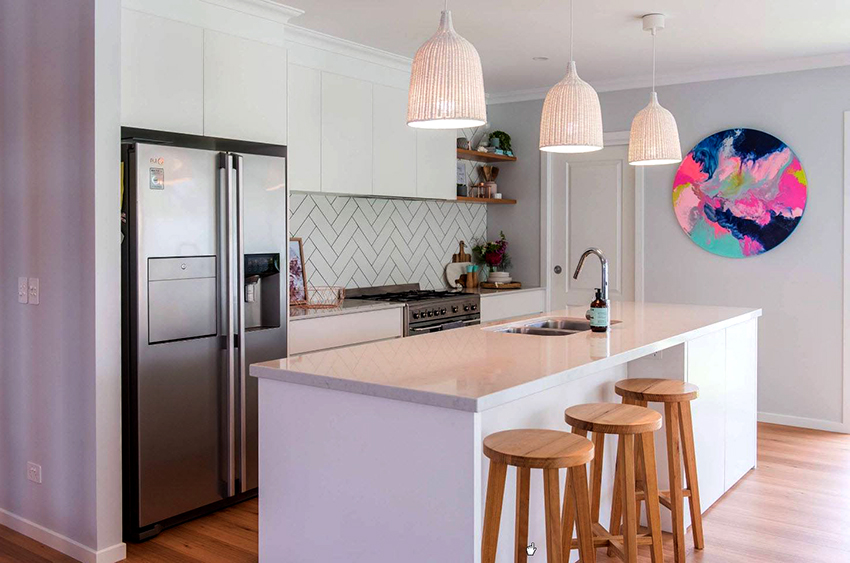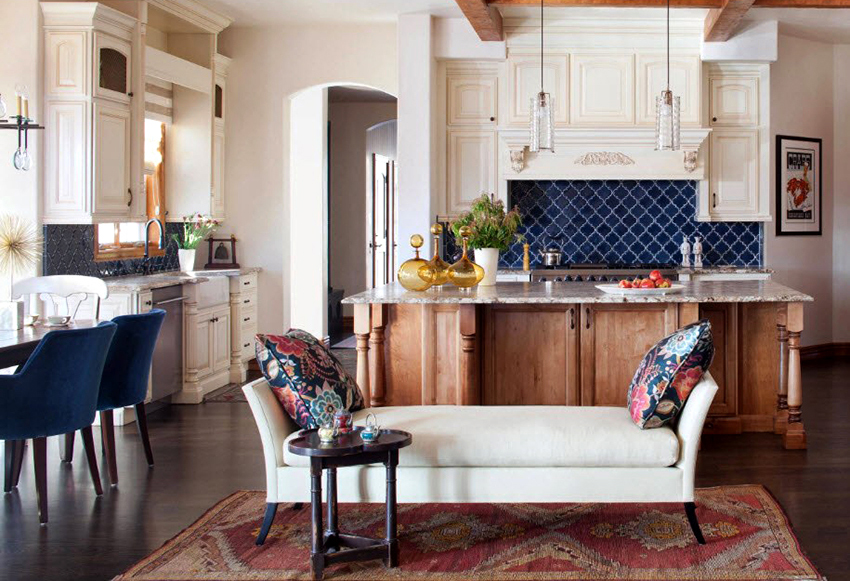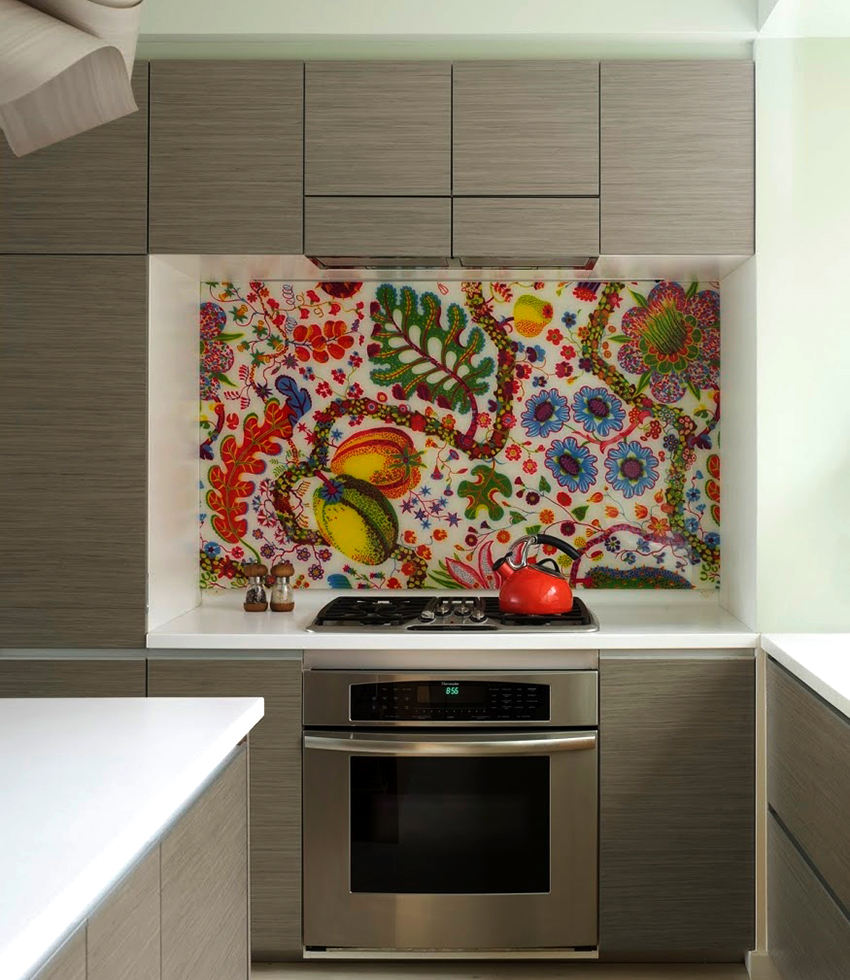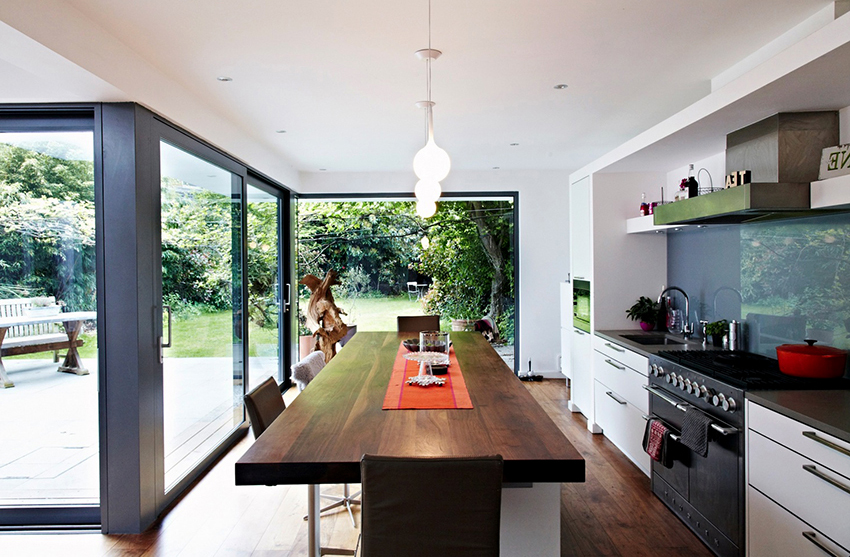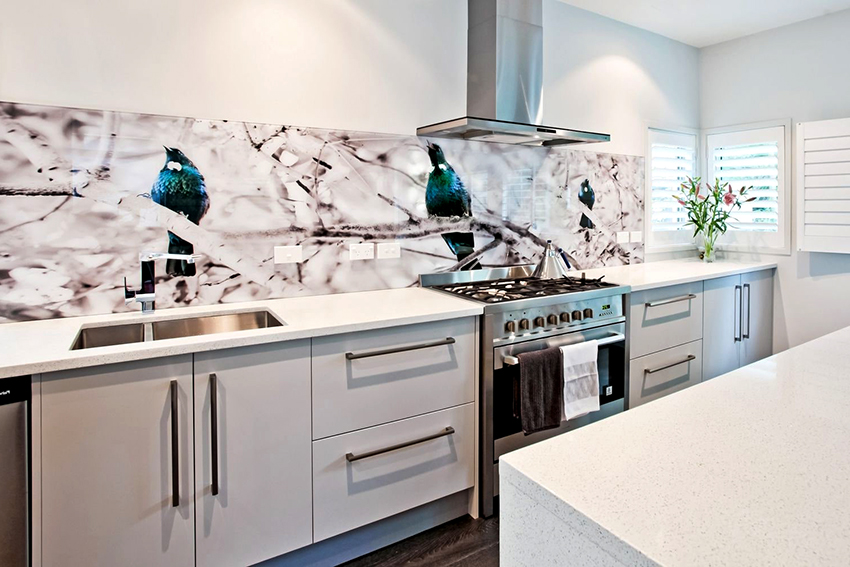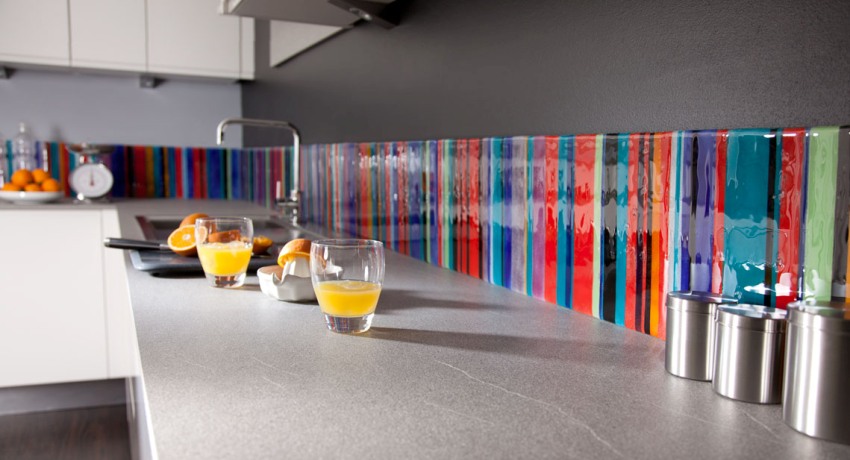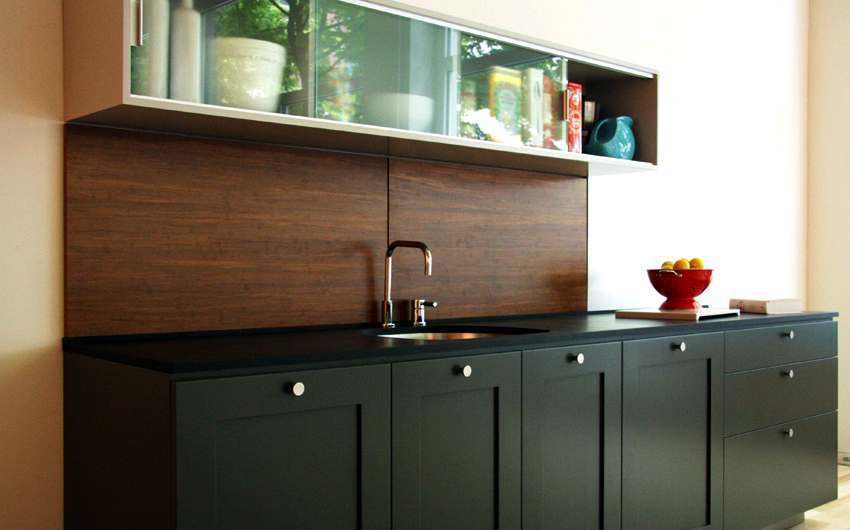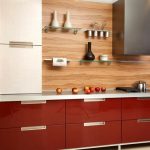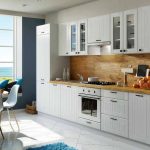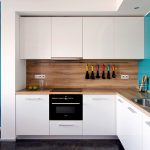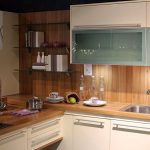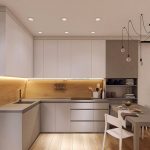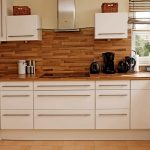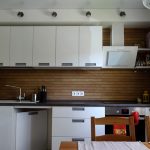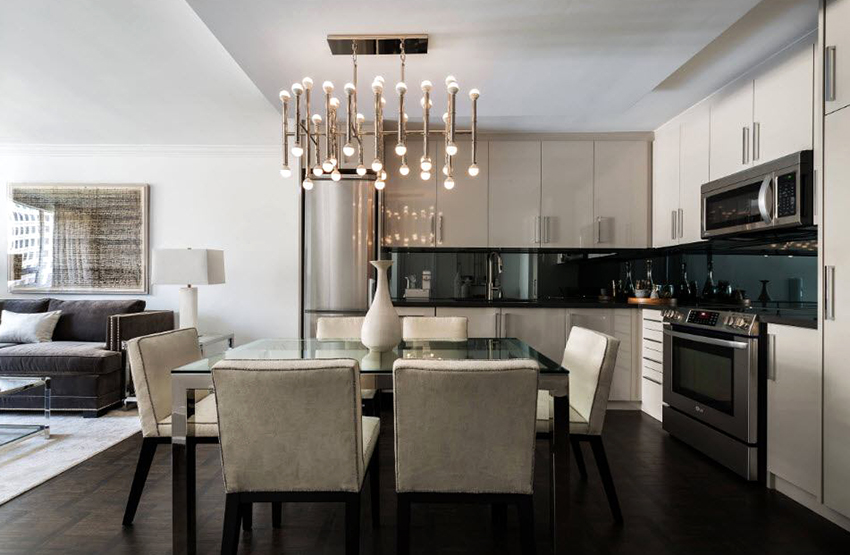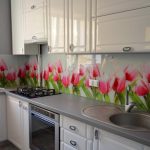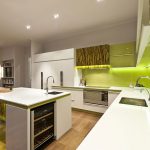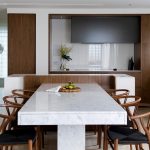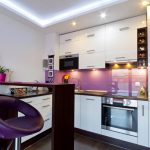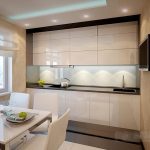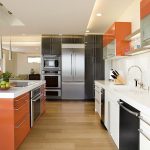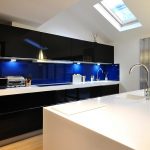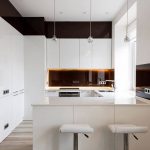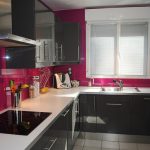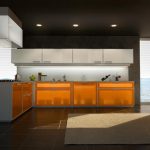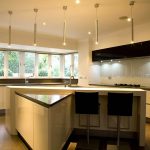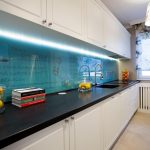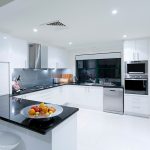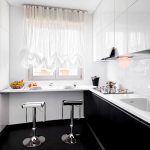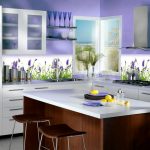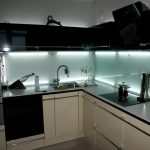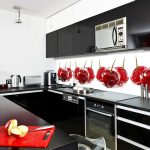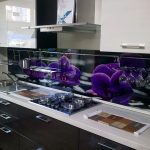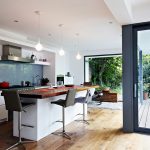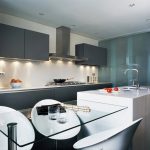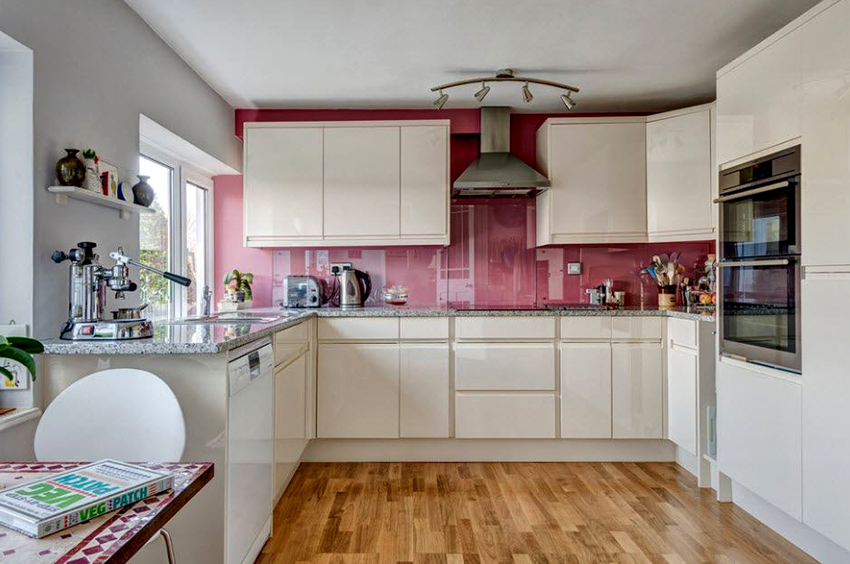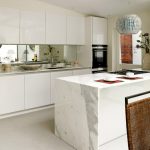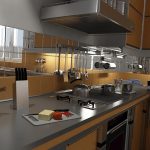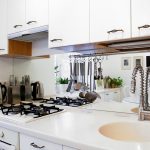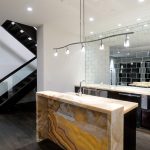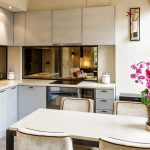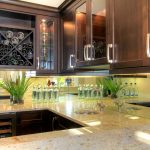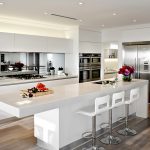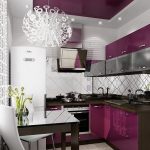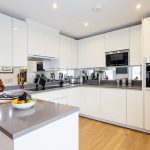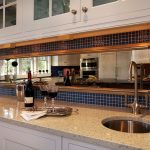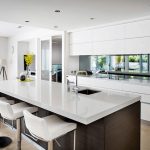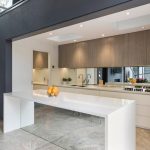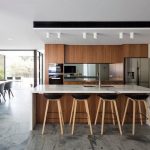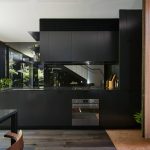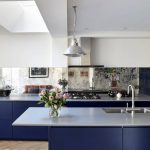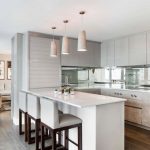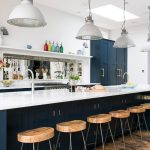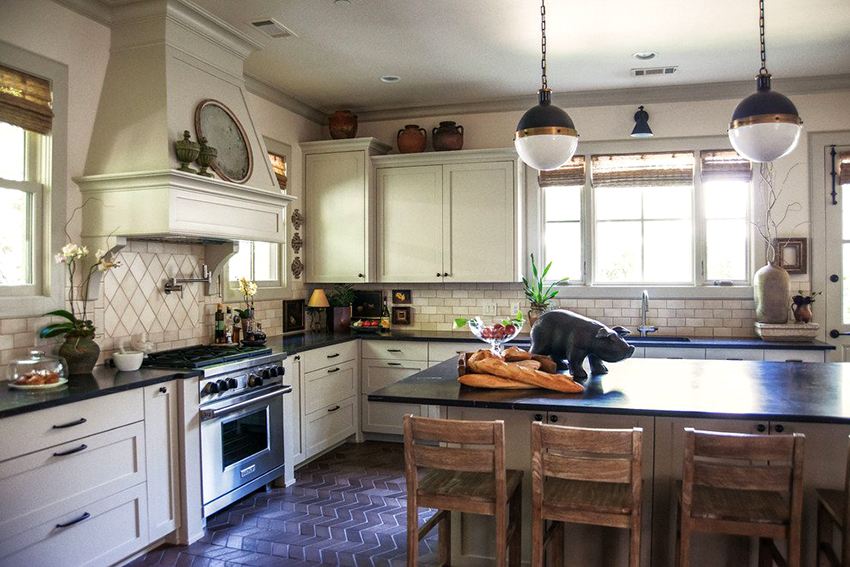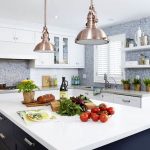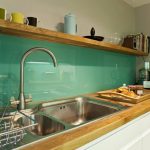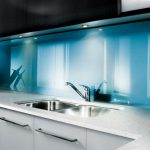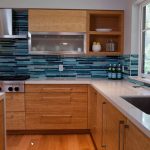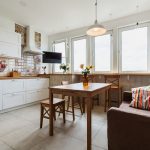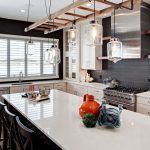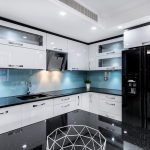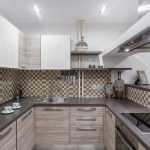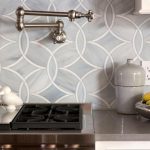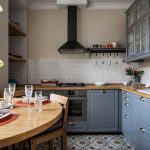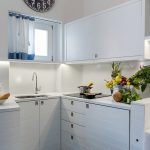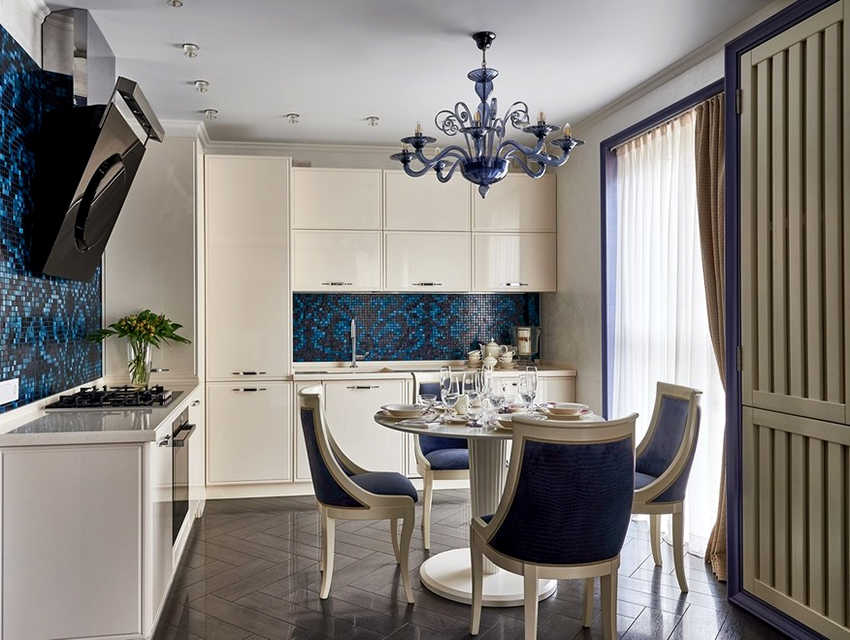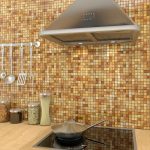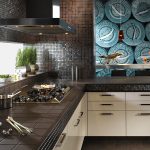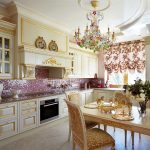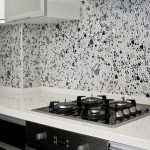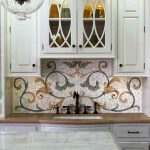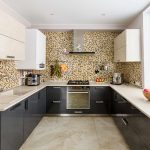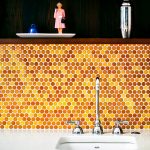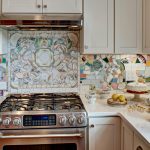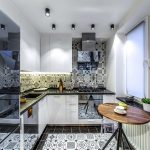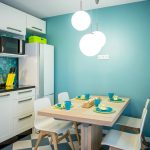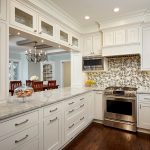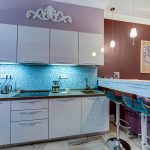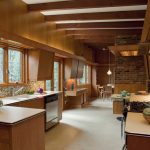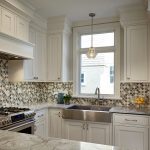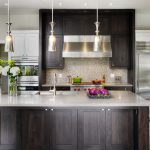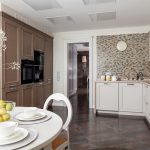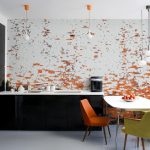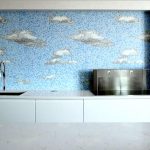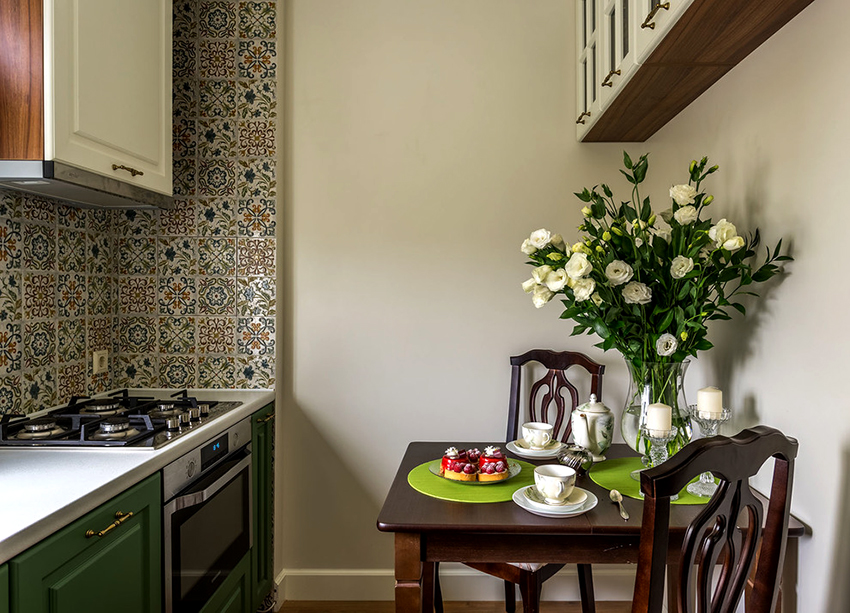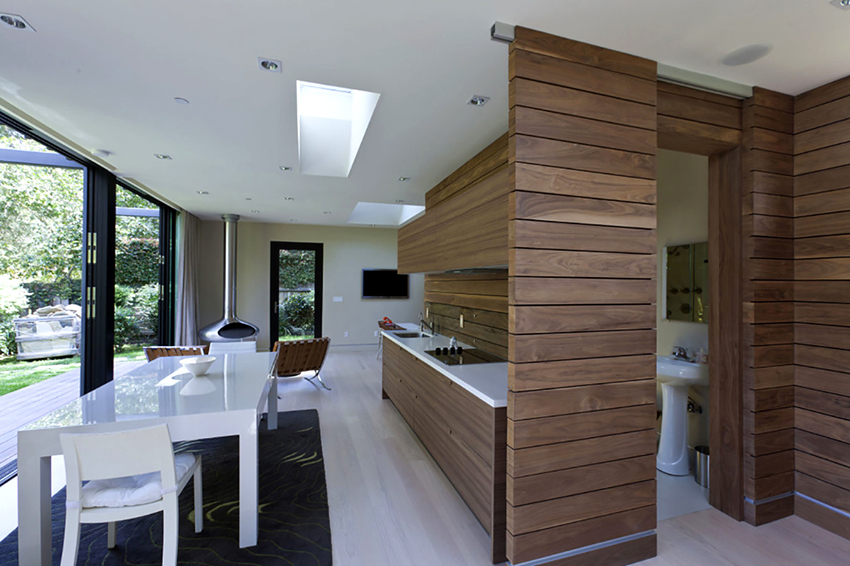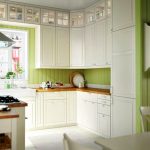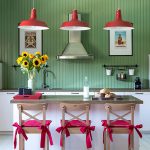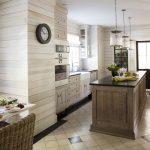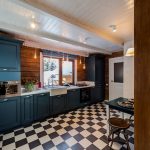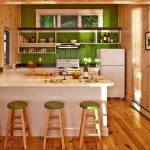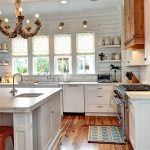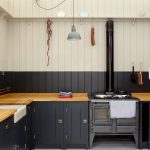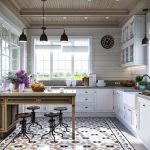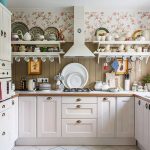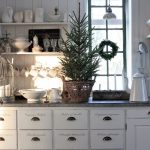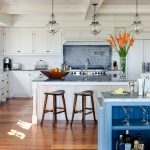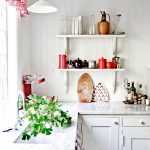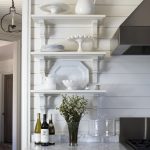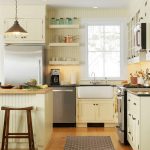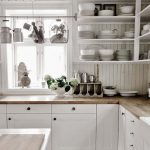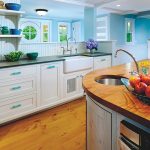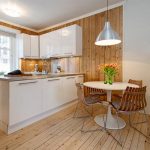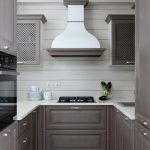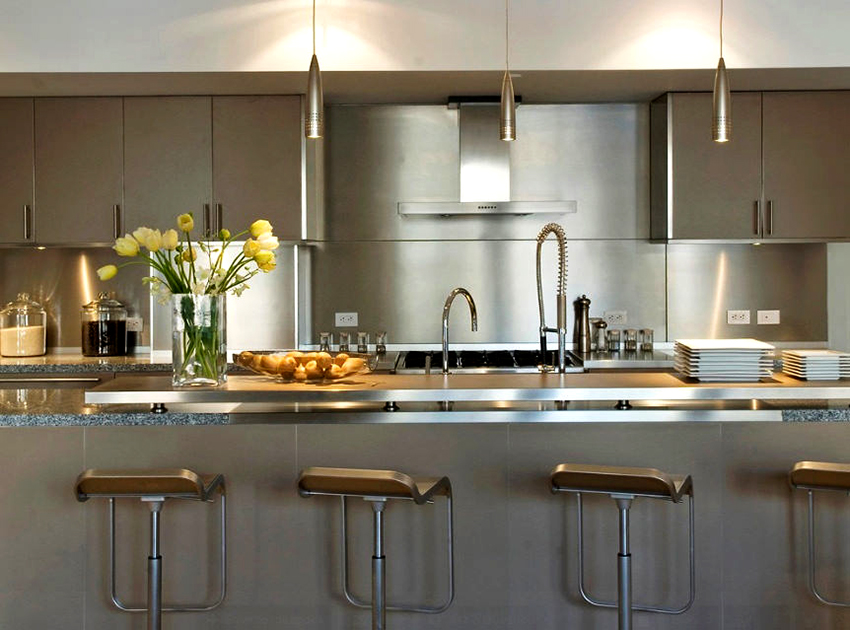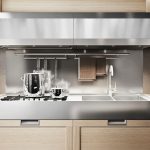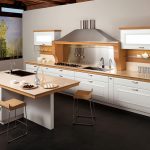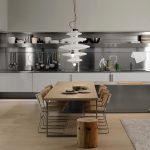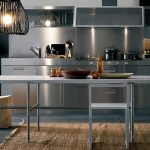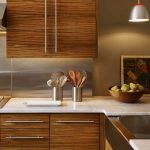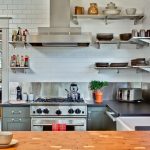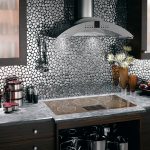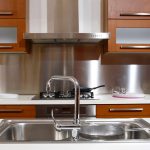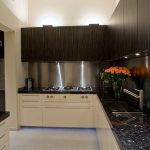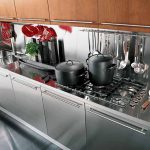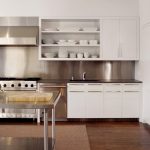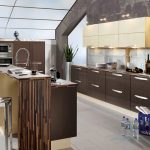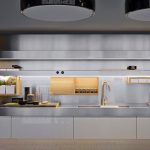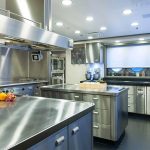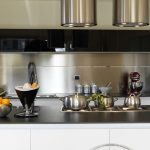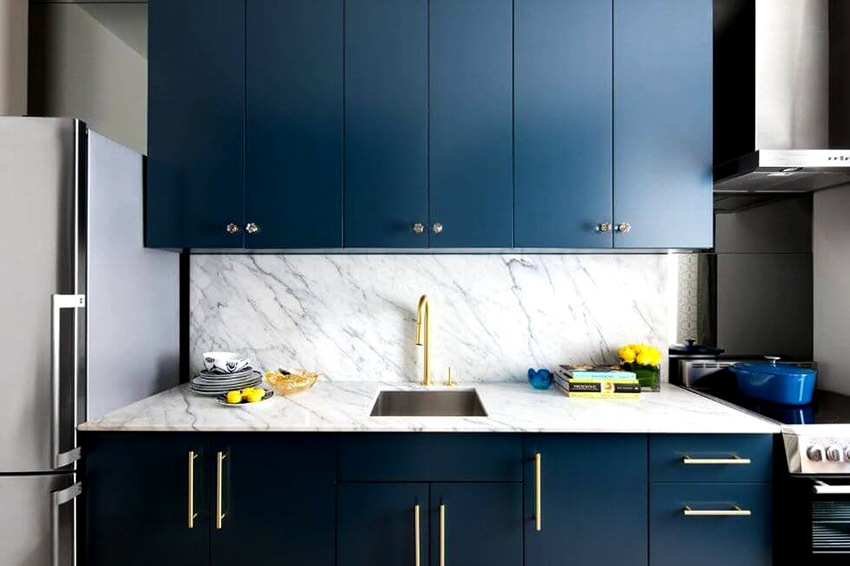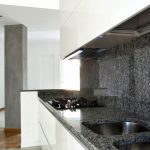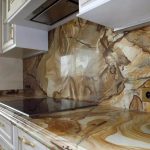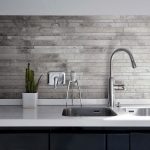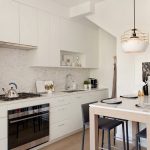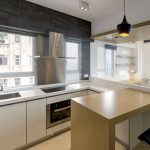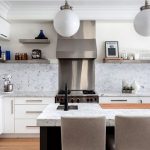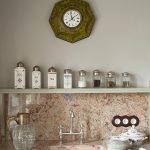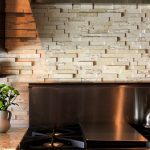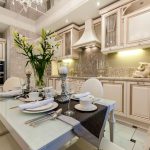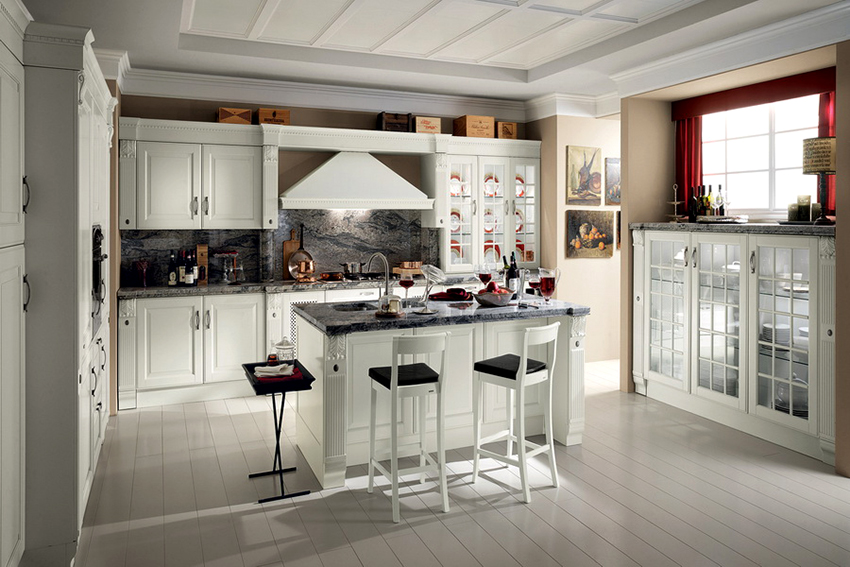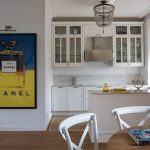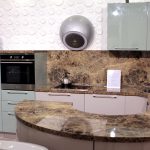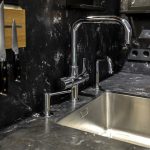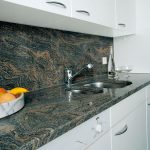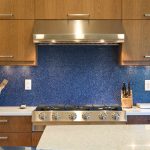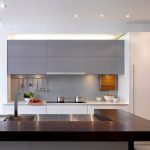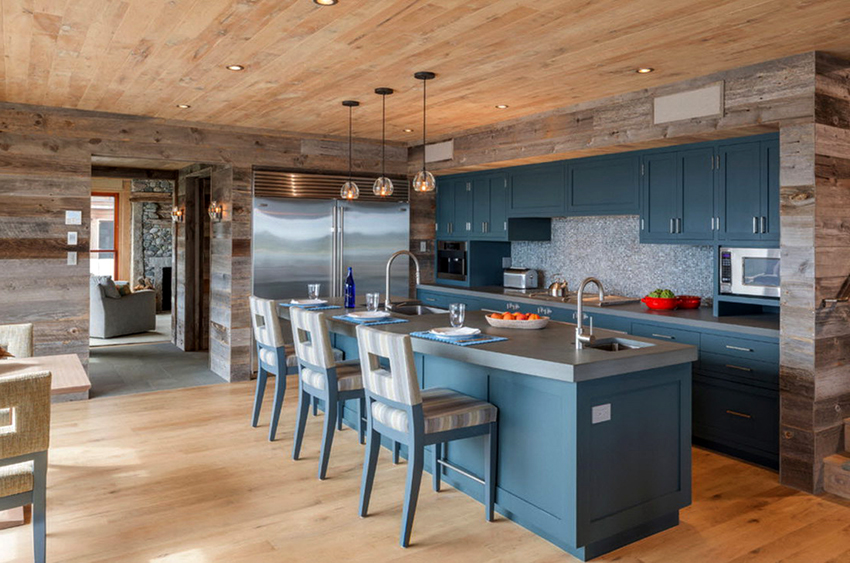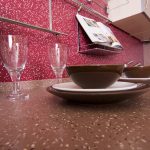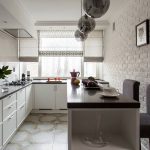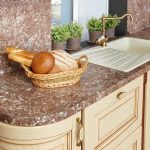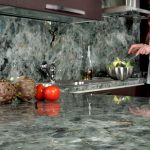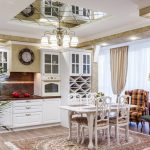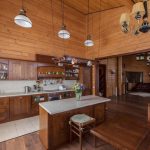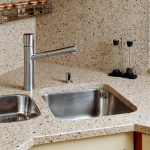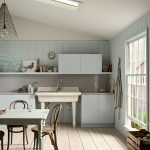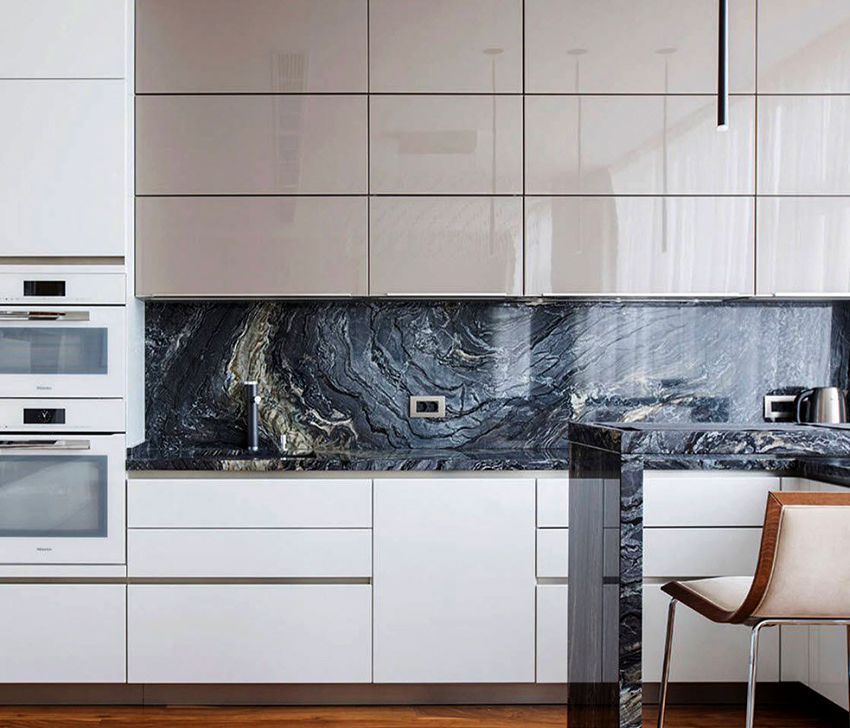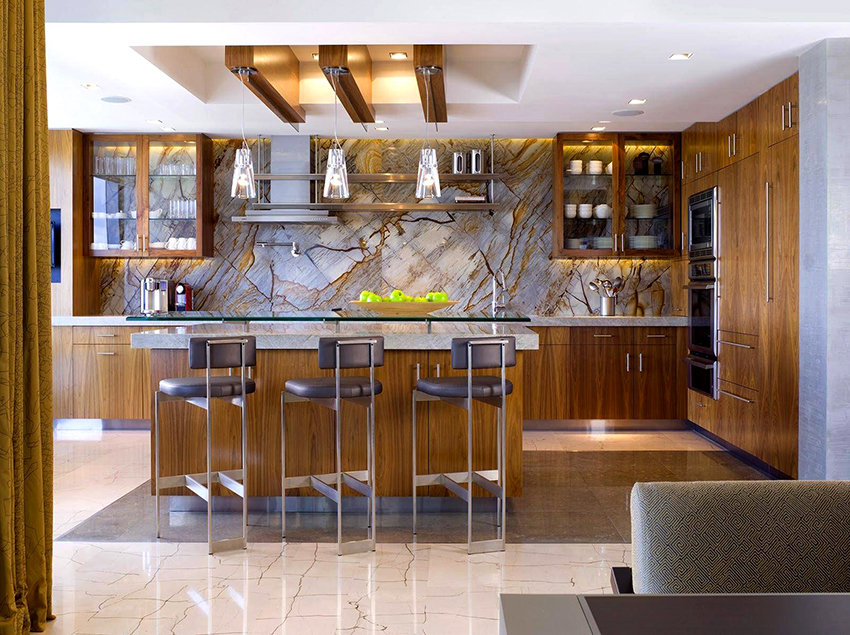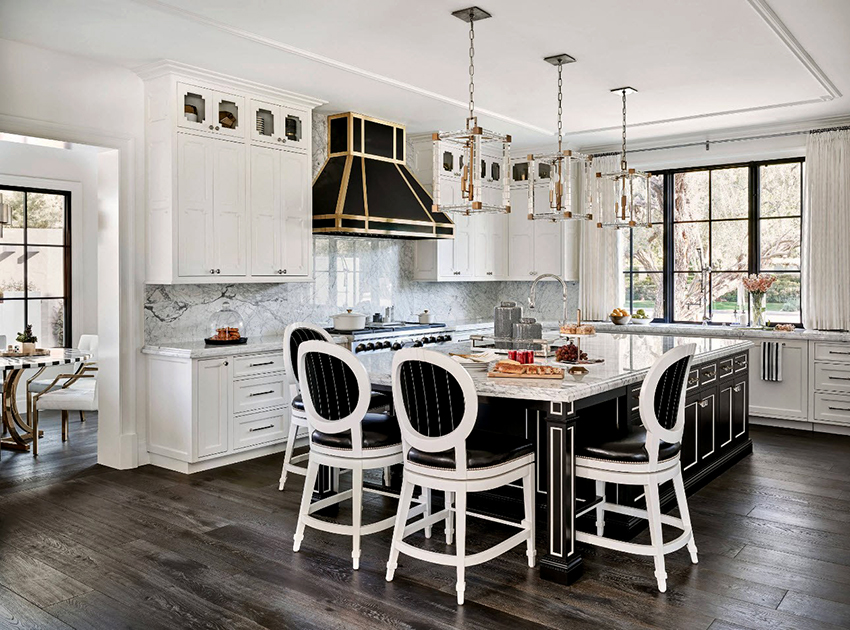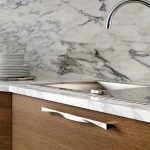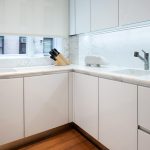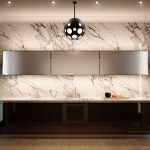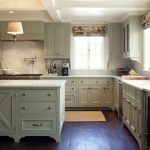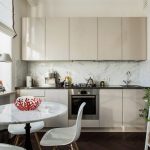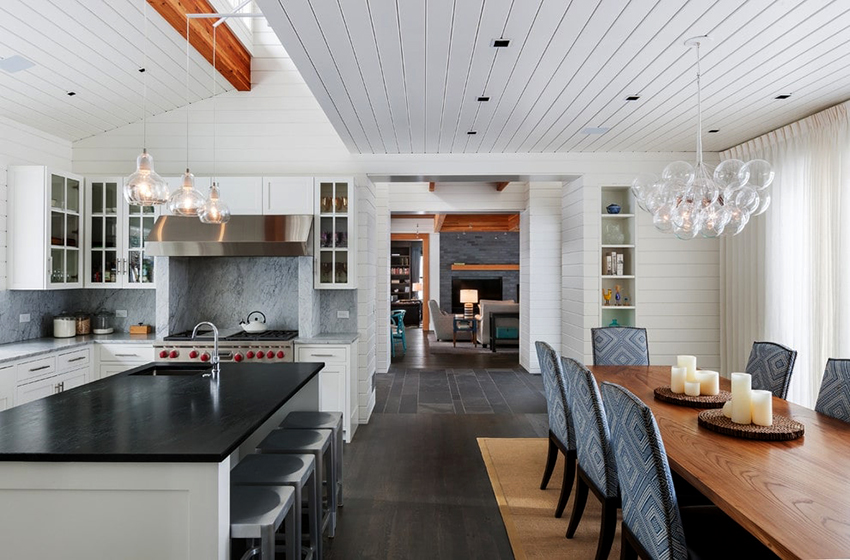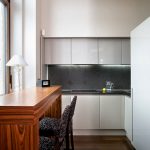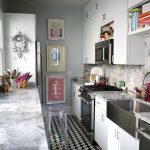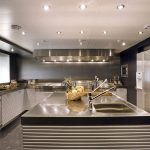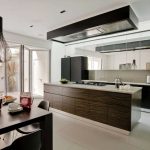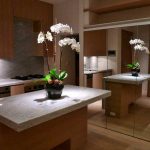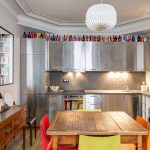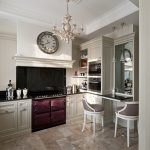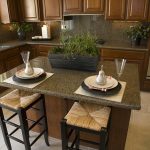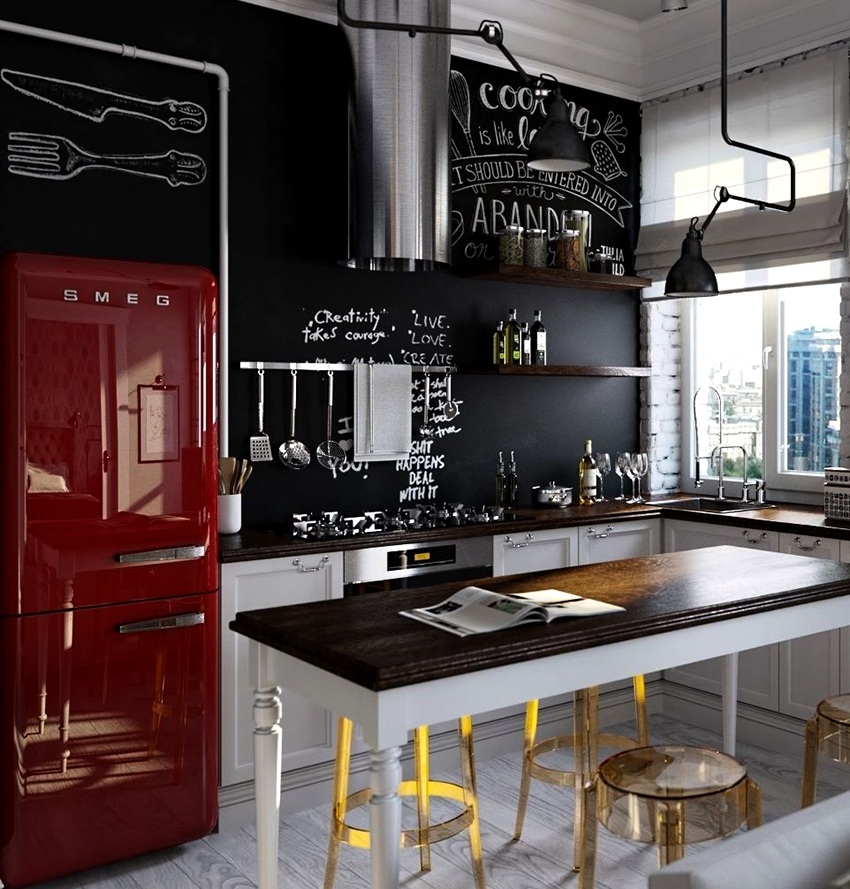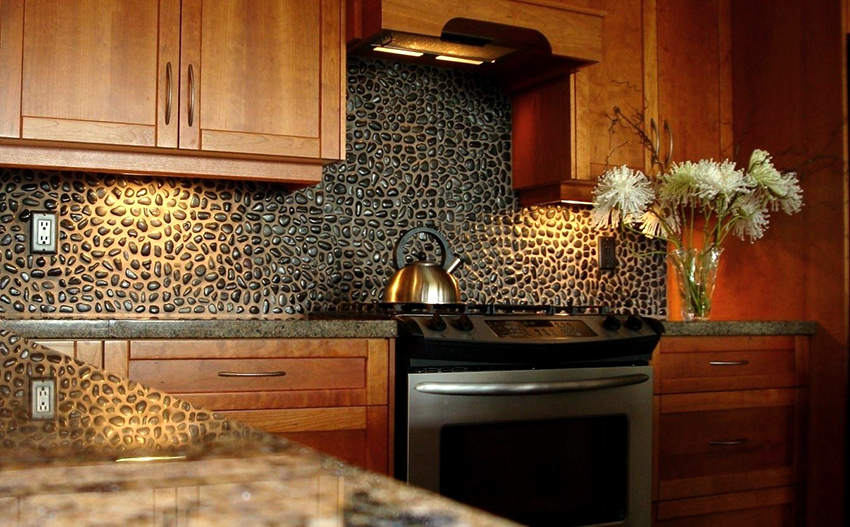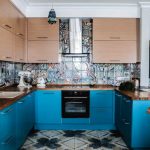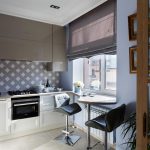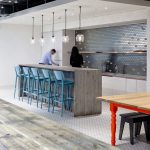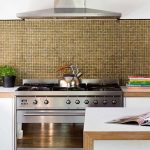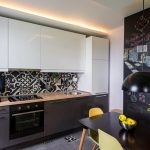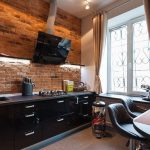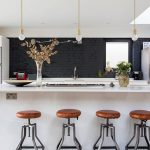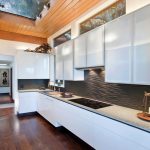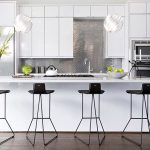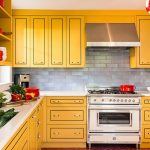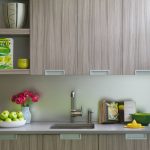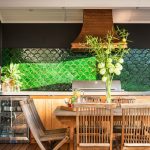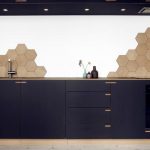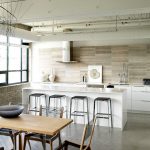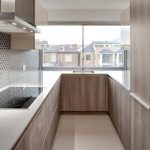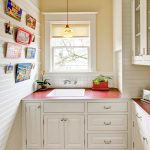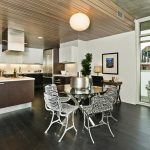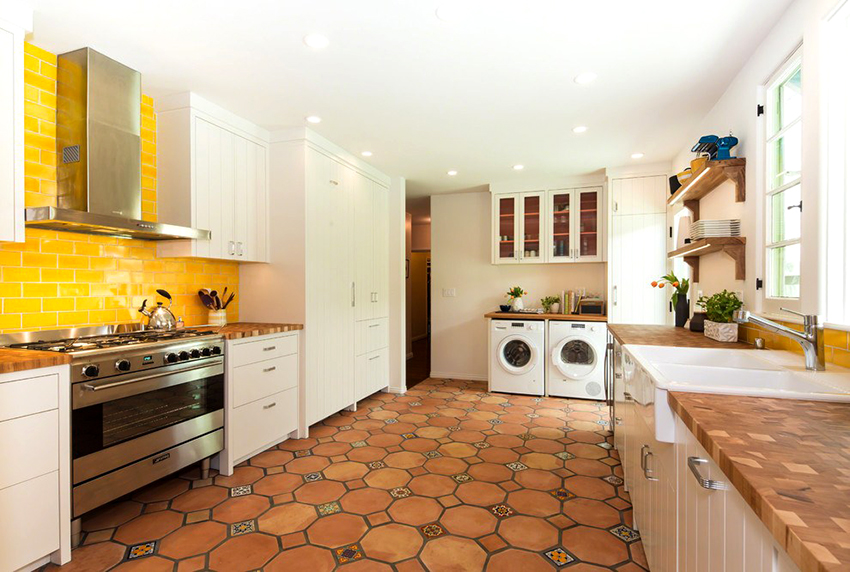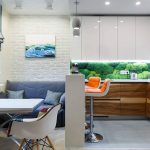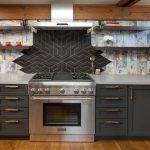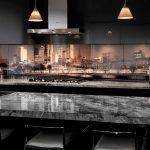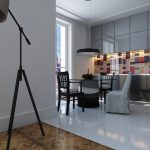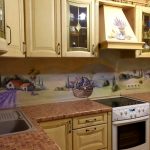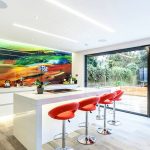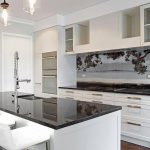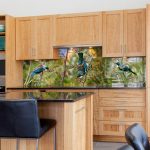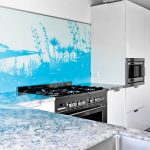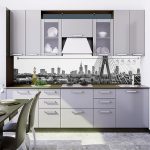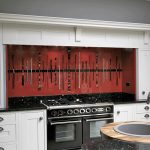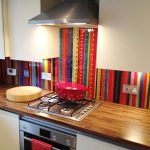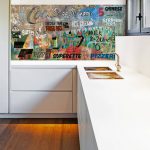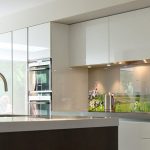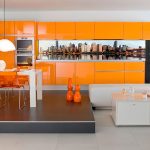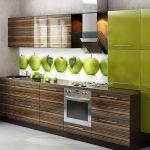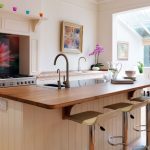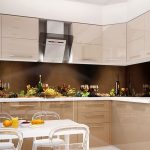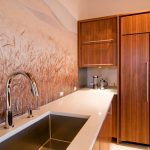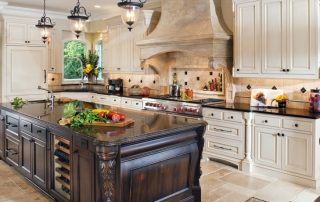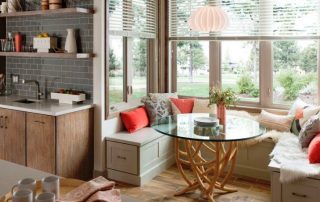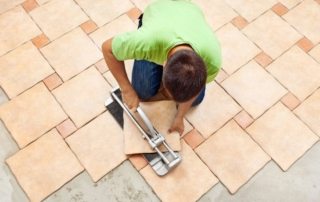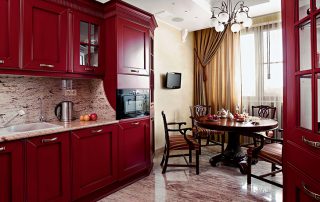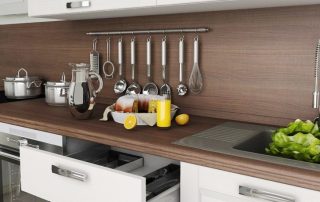A variety of materials are used to decorate the kitchen. The operating conditions of this room are very specific, so the choice of coatings for repairs should be considered. The apron for the kitchen occupies a special place in the interior of this room. From this article you can find out what features glass, ceramics, stone, plastic and other materials have, as well as get acquainted with their advantages and disadvantages.
Content
- 1 Finishing materials in the kitchen: options for aprons for the work area
- 1.1 Pros and cons of a ceramic backsplash in the kitchen: tiles as decoration
- 1.2 Features and photos of MDF kitchen wall panels
- 1.3 Specific properties of kitchen panels on a chipboard wall
- 1.4 Advantages and disadvantages of glass kitchen aprons
- 1.5 Mirror aprons for the kitchen: photos and features of use
- 1.6 Types of plastic kitchen aprons for the kitchen on the wall in the work area
- 1.7 Unusual tile design on the apron in the kitchen: photos of mosaic products
- 1.8 Lining kitchen aprons: plastic and wood sheathing
- 1.9 Advantages and disadvantages of stylish metal kitchen aprons: steel panels
- 2 Kitchen aprons made of stone: artificial and natural finishes
- 2.1 Features of artificial stone aprons: acrylic finish
- 2.2 Artificial stone apron: photos and features of products made of quartz agglomerate
- 2.3 Characteristics of stylish onyx and quartzite aprons
- 2.4 Advantages and disadvantages of a marble backsplash in the kitchen
- 2.5 Features of granite and basalt aprons in the kitchen
- 3 What to make an apron for the kitchen with your own hands: original ideas from unusual materials
- 4 How to choose an apron for the kitchen: design, sizes and prices of products
Finishing materials in the kitchen: options for aprons for the work area
Any kitchen can be divided into two functional areas: dining and working. One of them is used for eating and resting, and the second is used directly for cooking. The work area consists of a gas or electric stove, sink and countertop. These elements are usually installed against a wall next to each other, forming a single line.
In the process of cooking, all surfaces of the working area are inevitably contaminated, so it is impossible to keep the room completely clean. During cooking, various types of dirt get on the wall between the countertop and the kitchen set:
- splashing water;
- food particles;
- drops of juice that fly to the sides when cutting fruits and vegetables;
- vapor from pots;
- splashing grease from pans, etc.
The consequences of cooking can in most cases be eliminated by thoroughly cleaning the kitchen. However, the wall between the countertop and the headset will lose its attractiveness over time. As a result, redecorating will have to be done much earlier than we would like, even if the rest of the kitchen is in good condition.
All this can be avoided by installing a special "sleeve". Buying a beautiful and original apron for the kitchen will not only diversify the interior, but also eliminate the need to change the wall covering too often. These products are made of practical and durable materials that repel dirt well and are easy to clean. To do this, simply wipe the surface with a damp cloth.
Note! This cleaning method is suitable for glass and plastic surfaces, as well as tiled kitchen aprons.
The following materials are used for the manufacture of aprons:
- glass;
- plastic;
- mirror;
- stone (artificial and natural);
- tiles (tiles and mosaics);
- MDF, chipboard, etc.
Each of them has its own advantages and disadvantages. Therefore, when buying a product, be sure to pay attention to the technical and operational characteristics.
Pros and cons of a ceramic backsplash in the kitchen: tiles as decoration
As you can see in the interior photos, backsplash tiles in the kitchen are the most common finishing options. In comparison with other materials, it has an impressive list of advantages.
The ceramic coating does not need special care and is easy to clean. The tile has the property of repelling dirt. Grease and streaks can be removed from such an apron by wiping its surface with a damp cloth. Any cleaning agent can be used. If tiles with a matte surface are used to finish the kitchen backsplash, then you can even remove dirt from such a coating with the help of abrasive powders.
The tile compares favorably with many finishing materials for its long service life. During operation, it retains its attractive appearance, since it is not afraid of temperature extremes and high humidity. The ceramic coating does not fade even under the influence of sunlight, and is also characterized by increased fire resistance (in the event of a fire, this finish does not ignite).
Manufacturers offer a wide range of products. In store catalogs, photos of tiles for the kitchen are full of a variety of textures and colors. As a finish for the apron, you can use ceramic products with decorative patterns or tiles that imitate natural surfaces, such as wood, leather, granite or marble.
In addition, tiles of both premium and budget class are on sale. Therefore, each consumer will be able to choose a tile for an apron in accordance with his financial capabilities.
Using tiles as a decoration for an apron in the kitchen also has disadvantages. Of course, you can put the ceramic coating on the walls with your own hands and save money on this, but this process is quite time-consuming and laborious. In addition, tile laying requires certain skills and knowledge.
Note! The final cost of the finished apron will be significantly higher than the price of the tiles, since for the installation of ceramic products you will need to purchase a leveling solution, a special adhesive, and grout for joints.
Even if you perform a high-quality installation of the tiles, you still cannot get a perfectly flat surface, since the coating will consist of individual elements of a square or rectangular shape. Dirt will accumulate in the seams between the tiles.
Features and photos of MDF kitchen wall panels
Kitchen wall panels made of MDF have both advantages and disadvantages. Among the advantageous advantages of this material are the following:
- Affordable cost - MDF finish belongs to the category of budget materials, these panels are much cheaper than glass, ceramic tiles or mosaics.
- Simple installation system - installation of kitchen wall panels does not require professional skills and special knowledge, everyone can handle this work.
- Versatility - Despite the fact that the design of the panels is not as diverse as that of ceramic tiles, customers will be able to find products in the store that will be an excellent addition to the overall design of the kitchen.
Kitchen aprons made of MDF have significant drawbacks. These products are made of densely compressed wood. Manufacturers made sure that such coatings were moisture resistant, however, during operation, due to constant contact with water, the structure of the material gradually collapses. In comparison with tiles or glass, an MDF apron will last much less.
Since the panels are made on the basis of wood, the finishing of the working area will have a high flammability index. In the event of a fire, this coating is highly flammable. Pressed wood does not react well to mechanical stress. Over time, the wall panels installed in the kitchen will be covered with scratches and lose their attractiveness.
Given that MDF panels are sensitive to moisture, this coating requires special care. The finish will suffer not only from constant contact with grease and water splashes, but also from regular cleaning, especially if cleaning agents are used.
Despite the fact that MDF panels have many disadvantages and belong to the budget types of aprons for the kitchen, such coverings are very popular. The high demand for these products is due to their affordable cost and simple installation system, so you can independently change the finish when the need arises.
Useful advice! If you use self-tapping screws to fix the kitchen panel to the wall, the base is practically not damaged, which cannot be said about liquid nails. The adhesive composition more reliably fixes the finish, however, when replacing the apron with a new one, you will have to level the surface, which complicates the installation work.
Specific properties of kitchen panels on a chipboard wall
On the Internet, you can often find pictures of aprons in the kitchen with a beautiful wood design. Eco-friendly and natural interiors combined with modern appliances and furniture look very stylish. However, natural wood is not used to decorate the kitchen work area for several reasons.
Related article:
Glass apron for kitchen: how to choose and install a panel
Material requirements. Types of glass and design methods. Ways of attaching the apron. The advantages and disadvantages of this solution.
Firstly, it is impractical because the material is afraid of moisture and temperature extremes. Under such conditions, the wood will be covered with cracks, flake off and deform. Secondly, natural material is highly flammable. This type of finish is not the best option for being close to a gas or electric stove.Thirdly, natural wood is too expensive, so it is replaced with false panels for the kitchen from budget materials, for example, from laminated chipboard (postforming).
Postforming is a material consisting of pressed and glued wood, which is covered on all sides with a laminate (a layer of durable plastic). Similar panels are used for the manufacture of countertops, so most often the design of an apron for a kitchen is selected in tandem with work surfaces. The thickness of such products varies between 0.4-1.5 cm.
Advantages of chipboard panels:
- a simple installation system that does not require preliminary leveling of the wall surface;
- if necessary, the chipboard can be easily dismantled;
- does not need special care and is easy to clean;
- the ability to choose an apron design for a kitchen set that will repeat the colors and texture of facades or countertops with a wooden or stone surface;
- low price.
There are also many drawbacks to panels made from postforming. This material cannot be used as a finish on the wall section behind the slab. This is especially true for kitchens where gas is supplied, since chipboard has a high degree of flammability.
In addition, postforming is sensitive to aggressive cleaning, so its surface should not be abraded. To partially protect the apron from negative effects, sometimes chipboard is combined with resistant materials. Most often, metal inserts (stainless steel) or glass panels for the kitchen, which function as a screen, are used for this.
Useful advice! Aprons made of chipboard and MDF have seams between the sheets. To protect the material from moisture, it is advisable to cover these areas with corners and moldings, although the presence of these elements significantly complicates the cleaning process.
Advantages and disadvantages of glass kitchen aprons
This finishing option for the work area has been used relatively recently. Despite this, numerous photos of glass aprons in the kitchen prove how successful and relevant this design is. The cladding for the wall between the headset with a glass surface is called skinale. Due to its advantageous characteristics, the finish can compete with tiles in terms of convenience and practicality.
Benefits of using glass panels in the kitchen:
- Many manufacturers offer a turnkey service, which involves the production of glass and its installation, so the buyer does not have to separately look for a contractor to install the apron. Everything you need can be ordered in one place, thereby saving time.
- The smooth surface is good at repelling dirt. Even if you do not clean the working area in the kitchen for some time, the glass of the apron can be easily washed at any time to its original state.
- To remove surface contamination, you can use brushes and any cleaning agent, including abrasive powders.
- The glass surface is resistant to mechanical stress (not scratched), temperature extremes and direct sunlight.
- The glass apron is not afraid of fire.
- The service life of the skin is approximately 10 years.
- Panels have endless possibilities for kitchen design. Photo printing on an apron allows you to transfer under glass any images and photos of the appropriate size and quality that the buyer likes.
For the manufacture of aprons, not ordinary, but tempered glass is used. This material is safe and shock-resistant. Even if you try to break it, you cannot get hurt. When tempered glass breaks, it creates smooth pieces rather than sharp shards.Depending on the degree of transparency, there are two types of glass kitchen aprons: glossy and matte.
Disadvantages of glass panels:
- Cutting glass during its installation is impossible, since the dimensions of the kitchen apron are individual and they are set at the manufacturing stage.
- Installation of finishing can only be performed by specialists.
- High price.
Useful advice! Clear glass can be used in combination with less durable finishes. It will act as a screen protector for wood, wallpaper, posters, paint, photo collages and brickwork.
Mirror aprons for the kitchen: photos and features of use
If you want to install a stylish and unusual version of a kitchen apron in the kitchen, you should pay attention to products made of mirrors. This material is very rarely used as a decoration for the work area, but it looks luxurious. Facet mirrors look especially impressive in the interior, however, it is much more difficult to clean a faceted surface than a smooth one.
Before choosing a mirror as a decoration for a working area in a kitchen, there is one important nuance to consider. The reflective surface not only visually enlarges the space in the room, but also "doubles" the clutter and amount of dishes on the table. To avoid a feeling of clutter, it is advisable to maintain perfect cleanliness in such a kitchen, as well as to make the interior as “empty” as possible, that is, remove unnecessary items from the surfaces (hide dishes and small household appliances in a cabinet). In addition, it is not recommended to use roof rails.
If you want to fill the room with light and glare, it is still better to give preference to other types of aprons with shiny surfaces, for example, glass panels or tiles with a glossy finish. Mirrors are suitable for kitchens that are rarely used for their intended purpose.
Types of plastic kitchen aprons for the kitchen on the wall in the work area
Plastic aprons belong to the budget category of finishing materials. The purchase of such products is usually resorted to if temporary repairs are planned. They fit perfectly into the kitchen space, where the economy class furniture is installed. The existing types of plastic aprons can be divided into two categories.
Furniture boards lined with decorative plastic. This version of the products has already been described earlier, the basis of such aprons are fiberboard, MDF or particleboard panels with a polymer coating HPL. They can be made in solid colors or imitate other materials. On sale you can find beautiful aprons decorated with mosaics, ceramics, wood or stone.
Polyvinyl chloride (PVC) wall panels. The products are flexible plastic screens that are fixed to the wall using aluminum profiles or a special adhesive. This type of material has a small thickness, so it is less durable than furniture boards. PVC panels are inferior to them in terms of practicality, since their surface quickly fades, and is also afraid of high temperatures.
Useful advice! Plastic panels will be an excellent training option if the repair work is done by hand.
In the photo, aprons in the kitchen made of plastic are almost indistinguishable from skinned, however, live these coatings do not look so aesthetically pleasing. If financial opportunities are limited, it is better to give preference to postforming than PVC plastic screens.
Features of plastic aprons:
- the surface can withstand the effects of moisture and hot steam, however, being in the immediate vicinity of an open flame, it lends itself to deformation changes;
- PVC panels lend themselves well to cleaning; to remove dirt, it is enough to use a damp cloth and soap;
- it is not recommended to use abrasive products for cleaning, since they leave unattractive scratches on the surface of the material;
- when thinking about which apron to choose for the kitchen, it is advisable to consider products consisting of a single sheet of plastic, since grease and dirt will accumulate in the seams, which are difficult to remove during cleaning.
When buying a plastic screen, be sure to pay attention to the parameters of the product. The apron must be safe and environmentally friendly. It is better to give preference to models made of the same polyvinyl chloride as the utensils for food.
Unusual tile design on the apron in the kitchen: photos of mosaic products
Mosaic coverings look very stylish. This version of aprons is in great demand, although it is not without certain drawbacks. The fact is that products decorated with mosaics have a considerable number of seams. It is in this zone that the most dirt accumulates, which is a significant disadvantage.
Compared to the tiles used in the kitchen, an apron with a tile finish will have one horizontal seam and 3-5 vertical ones, and with a mosaic there will be hundreds of such joints.
For arranging a mosaic apron, experts do not recommend using an ordinary fugue (grout for joints), because in this case the coating will very quickly lose its presentable appearance. The best option would be an epoxy fugue, which is distinguished not only by its excellent quality, but also by its high cost. Therefore, you will have to spend a lot on a kitchen with a mosaic apron, or simply abandon this option in favor of a different material.
Alternatively, you can use aprons decorated with pseudo-mosaics. These products are finished with tiles that very realistically imitate the pattern and texture of a real mosaic.
Useful advice! If you choose a grout to match the seams, then the pseudo-mosaic from the tiles will be as similar as possible to a real coating.
Pseudo-mosaic, in addition to its affordable price, has another significant advantage. The area of the seams on such a coating is much smaller than that of its real counterpart.
A common mosaic has the form of a grid-matrix, on which small details of the finishing material are stacked. For the manufacture of these elements are used:
- a rock;
- ceramics;
- glass;
- metal;
- porcelain stoneware;
- smalt (one of the most durable materials).
Sometimes manufacturers resort to combining these materials. Particularly impressive are the “chameleon” coatings, which change colors at different viewing angles depending on the lighting.
Advantages of mosaic aprons:
- Long service life. High-quality material retains its attractiveness and characteristics for 20-25 years.
- High degree of strength.
- With the help of this material, it is possible to perform cladding of not too flat and even curved surfaces.
- Excellent decorative qualities and the ability to create unique and complex artistic compositions.
Among the disadvantages of this material are the high price, as well as the difficulties that arise during the installation of the coating and its maintenance.
Lining kitchen aprons: plastic and wood sheathing
Despite the numerous shortcomings of this material, aprons made of plastic lining can still be found in kitchen interiors. This type of cladding is considered the most budgetary. But this is perhaps his only plus.
Cons of plastic lining:
- the material is very flimsy and thin, it can be easily pierced with a knife;
- the lining undergoes deformational changes under the influence of direct sunlight and quickly burns out;
- being in the immediate vicinity of open flame sources, the plastic melts from high temperatures, so it is not suitable for finishing the area above the stove;
- the design of kitchen aprons made of plastic lining can hardly be called modern and attractive.
The wooden lining, on the other hand, looks very cozy. However, it is inexpensive. This finish is ideal for kitchens with country or Provence interiors. Installation of such a coating can be done independently without resorting to the services of specialists.
The disadvantage of lining aprons is that they are not as easy to clean as tiles and other smooth-surfaced materials. In addition, wood is afraid of moisture and deforms under the influence of temperature.
Useful advice! If you cover an apron from a wooden lining with a dense layer of varnish or washable paint, you can protect the material from the negative influence of external factors, as well as facilitate the maintenance of the finish.
Advantages and disadvantages of stylish metal kitchen aprons: steel panels
It is not common to find a work area finished with metal embossed sheets. Not every housewife would prefer to install an apron with such a "cold" design in the kitchen. In addition, such a finish costs a lot. On the other hand, it should be noted that metal panels are perfectly combined with hob and other household appliances, as well as accessories made of stainless steel.
Steel trim can be used not only for hi-tech and techno interiors: similar aprons are suitable for other kitchens as well. The drawings on these products, which can be three-dimensional, expand the possibilities for design. Interiors look especially impressive in which there is a relationship between the design of the working area and decorative elements in the room or pieces of furniture.
Benefits of a metal finish:
- Stainless steel is not afraid of high temperatures, it is not so easy to damage it. In addition, the metal does not burn out.
- Stainless steel does not absorb substances, therefore, no traces remain on the apron when products and other types of contaminants get on its surface. This apron does not accumulate unpleasant odors.
- The metal panels are easy to clean. To do this, you can use water in combination with detergents.
- The surface repels moisture, when drops hit the apron, they flow down.
- By regularly maintaining your metal finish, mold and harmful bacteria will not grow on the surface.
- Neat appearance.
Besides the high cost, steel panels have another disadvantage. To clean an apron made of this material, do not use hard metal brushes or scouring pads, because they leave scratches on the surface. It is also not recommended to use detergents for these purposes, which contain abrasive particles.
Kitchen aprons made of stone: artificial and natural finishes
Some buyers prefer to use stone for kitchen decoration, and the finish of the apron can be both natural and artificial. The following materials fall into this broad category:
- blocks made from natural rocks;
- porcelain stoneware;
- concrete and plaster tiles with imitation of a stone surface;
- brick and clinker tiles;
- artificial finishes imitating the colors and texture of natural stone.
Useful advice! When choosing any finishing material, you need to take into account the texture of its surface. Coatings with complex and elaborate textures are less easy to clean.
Positive qualities of natural stone:
- Resistance to high temperatures, as well as temperature extremes.
- Low moisture absorption - thanks to this characteristic, natural stone is not afraid of water and steam. The degree of moisture absorption of porcelain stoneware is 0.05%. The index of clinker tiles, which are made from clay, and then fired and coated with glaze, is 0.2-0.3%.
- Hygienic - the surface of the material does not have favorable conditions for the growth of bacteria harmful to health.
- Excellent decorative qualities, allowing you to choose aprons for classic kitchens, as well as interiors made in modern styles.
- Environmental friendliness and safety.
This list provides a list of common benefits. Each type of natural stone has its own characteristics, advantages and disadvantages. The same goes for artificial coatings.
As for the disadvantages of natural stone, there are not so many of them. The most significant disadvantages of this material are the high price, complex installation technology, and low maintainability.
Features of artificial stone aprons: acrylic finish
Acrylic stone is made from plastic. In production, a panel of the required shape and size is cast from a liquid polymer mass, which is covered with a texture that imitates a stone surface. This type of material is quite lightweight and warm to the touch. Aprons made of acrylic stone come in a huge variety of colors. If necessary, you can get a product with a complex shape.
Note! The acrylic surface is easily scratched, however, using the same polymer mixture, damage can be covered. Of course, such work must be performed by a specialist.
Disadvantages of acrylic stone:
- Like all materials of polymer origin, acrylic is afraid of exposure to high temperatures, so it cannot be used to finish the area around the slab.
- The acrylic surface must not be treated with aggressive chemicals. To clean the apron from dirt, you need to use certain detergents.
- Do not use iron brushes, scouring pads or abrasive powders to clean the acrylic panel, as white spots and damage may appear on the surface.
Acrylic stone is also used for the manufacture of countertops, so you can order the apron in colors identical to the work surfaces.
Artificial stone apron: photos and features of products made of quartz agglomerate
Agglomerate is a stone of artificial origin, for the manufacture of which stone chips are used. It is pressed and held together with plasticizer resins. The agglomerate also contains coloring pigments. Manufacturers strive to achieve an optimal ratio between the amount of natural components, resulting in an original high quality apron.
There are several varieties of this material, which may differ in texture, color and decorative surface features. The appearance of the material depends on the chosen production method:
- varieties of coloring pigments;
- sizes of fractions of industrial raw materials (quartz chips);
- surface treatment method;
- the presence of decorative additives.
Quartz agglomerate is just as cold and heavy as natural stone, but more practical.
Advantages of quartz agglomerate aprons:
- High degree of strength. The material will not split even if it is hit hard with a hammer.
- Resistant to high temperatures.
- Metal brushes can be used to clean the surface.
- The material does not accumulate dirt and does not absorb odors.
The agglomerate has a stereoscopic depth that is not found in other materials. To create beautiful aprons for the kitchen with a similar effect, large particles of quartz with a high degree of transparency are used. It should be noted that the presence of natural stone chips in the composition of the material has a positive effect on its strength characteristics. Sintered aprons are also wear resistant.
Important! The agglomerate is 10% plasticizers. On contact with bleach, these components lose their color, therefore it is not recommended to use this agent for cleaning surfaces.
Special additives improve the appearance of kitchen wall aprons. For this, decorative glass is used. If you add mirror chips to the material, the surface of the agglomerate will overflow.
Characteristics of stylish onyx and quartzite aprons
Onyx is a beautiful natural stone with bright and variegated colors, and the range of shades of this material is very diverse. When creating a kitchen interior around an apron with such a flashy design, it is very important not to overload it. It is advisable to select textiles and pieces of furniture made in soothing colors for the room, since onyx will play the role of the main accent.
To get a solid and beautiful interior, you can support the design of the onyx kitchen apron by hanging a decorative object made from the same material on the wall. This stone has a translucent structure. By combining this material with LED backlighting, you can achieve an interesting effect.
Onyx is a rather expensive stone, however, due to its decorative qualities, you can close your eyes to this drawback. This material is unpretentious to maintain. The onyx used to make aprons is carefully polished. This surface does not absorb moisture and grease drops. Natural onyx is not afraid of bleach, however, you should not use abrasive products for cleaning this material. Particles in their composition can scratch the surface.
Quartzite aprons are as bright and colorful as those made from onyx. The difference between these materials lies in several nuances. First, quartzite aprons are cheaper than onyx aprons. Compared to granite, this material will be slightly more expensive. Secondly, quartzite is opaque, so you won't be able to use LED backlighting.
The surface of quartzite has pearlescent tints of different shades. The color scheme depends on what color the slab had in its original form. This material does not need any special care.
Useful advice! If you install a dark quartzite apron in the kitchen, thanks to the variegated surface, stains and traces of grease will not be visible on it.
Advantages and disadvantages of a marble backsplash in the kitchen
An apron made of natural marble looks expensive and high-status. This can be noticed immediately, because the decorative qualities of this material are simply excellent. The surface of the stone is translucent, delicate and luminous. The color of marble is usually a combination of two shades. The base of the stone is white, and impurities can be:
- brown;
- gray;
- green;
- red.
Mostly marble is used as a floor finish. As a material for the manufacture of aprons, it is rarely used. This is due to the numerous shortcomings and capriciousness of marble.
Cons of marble finishes:
- The material needs special care: the surface of the marble apron will have to be constantly treated with special mastic. The stone has a porous structure, and the regular use of this tool will close the voids.
- Marble cannot be called a practical material: due to its porous structure, this stone instantly absorbs coloring liquids, such as juices, wine, coffee.
- A marbled white apron in the kitchen absorbs grease well.
The service life of a marble apron is only 5 years, since it is far from always possible to instantly wash off dirt and greasy stains from the surface. In addition, many owners forget to regularly rub the stone with mastic. After this period, the appearance of the apron will be unattractive.
Features of granite and basalt aprons in the kitchen
Granite is a natural stone with excellent strength characteristics. Its performance is much better than that of marble. The colors of the granite rocks are varied. More than 200 titles of this material can be found on sale. Black aprons look most impressive in the kitchen. The following shades are also popular:
- green;
- red;
- blue.
It should be noted that it is not so easy to find bright decorative colors of granite. These aprons are usually custom made and cost a lot of money.
Advantages of granite products:
- practicality;
- high strength indicator;
- durability;
- resistance to moisture;
- lack of reaction to household detergents;
- presentable appearance;
- the surface does not absorb odors.
The disadvantages of granite are its high price, as well as the presence of radioactive radiation.
Important! The extraction of stone can be carried out from private quarries without checking the radioactive background. Buying products made from this material can be risky. Therefore, before purchasing a granite apron, you must make sure that the seller has the appropriate certificate.
Basalt aprons belong to this category of materials. These products are made from black granite. They have a smooth and shiny surface, they look very stylish and strict.
What to make an apron for the kitchen with your own hands: original ideas from unusual materials
Even if there is no suitable option among the standard solutions, you can always use a creative streak and make your own apron from scrap materials. What to make an apron in the kitchen? For this can be applied:
- slate paint or board;
- patchwork from the remnants of wallpaper;
- shards of ceramic dishes and tiles;
- sea pebbles;
- metal lids from glass bottles;
- parquet floor after repair;
- wine corks, etc.
The technology of creating a do-it-yourself apron for the kitchen from sea pebbles
Owners of housing located on the seaside can use pebbles to make an apron. This finish looks unusual and original, while the costs will be minimal. Of course, you will have to spend a certain amount of time collecting building material, but the result will be amazing.
For work you will need:
- several buckets of sea or river pebbles;
- cement mortar;
- brush;
- putty knife;
- colorless varnish composition.
First, a cement mortar is applied to the wall where the apron will be installed. Then the pebbles, depending on the selected design, are laid out on the treated surface on the edge or flat. With its help, you can create masonry or create a beautiful decorative pattern using elements of various sizes and colors. It is advisable to start work from the bottom of the apron, so that each next layer is supported by the previous one.
Important! In the process of laying, it is imperative to hold each pebble for a short time so that the solution has time to grab a little, and the pebbles are firmly fixed on the wall.
After the masonry is completely dry, the surface of the apron should be wiped with a damp cloth or sponge to remove traces of cement from the finish. Then you need to wait a little more for the pebbles to dry out, and cover it with a colorless varnish.
How to choose an apron for the kitchen: design, sizes and prices of products
Usually, the design of the apron is selected taking into account the design of the countertop in the kitchen, although this is not necessary. Both of these elements can be made from the same material, such as natural or artificial stone. If this is not possible, it is not difficult to choose a finish for the apron that is as close as possible to the countertop in texture and color.
A dark apron is not the most practical option for the kitchen. Water droplets and dust will be visible on its surface. On the other hand, greasy stains are not so visible on the black finish, especially if the material is not solid. If an apron of a bright color or with a colorful pattern is selected for the kitchen, then the interior of the room should be decorated in neutral colors.
To visually expand the space of a small kitchen, you should choose an apron with a large number of horizontal lines. The best option would be skinny with a striped pattern. For the same purpose, you can decorate the apron in the kitchen with "hog" tiles. When choosing an apron, of particular importance are:
- practicality and quality of the material;
- design and colors;
- product dimensions;
- price.
The size of the apron in the kitchen is selected taking into account the dimensions of the room. Typically, the protective cover is installed along the tabletop along the entire length of the working area. Partial wall overlap is allowed in the most problematic areas, for example, at the sink and near the stove. It is preferable to protect the entire surface of the working area.
In most kitchens, the apron height is standard, it is 50-60 cm. This indicator is optimal for people of tall and medium height. An apron with a height of 45-55 cm will be convenient for short households.
Useful advice! If the headset cabinets are equipped with door closers that open upwards, it is advisable to slightly cut the height of the apron, otherwise it will be inconvenient to use such furniture.
The cost of products depends on several factors:
- material of manufacture;
- the width and height of the apron in the kitchen;
- the chosen design;
- the presence of cutouts for the installation of sockets and holes for fasteners.
Price table for kitchen aprons made of different materials:
| Material | Price, RUB / m² |
| Tile | from 950 |
| ASB plastic | from 1400 (pcs.) |
| Porcelain stoneware | from 1500 |
| Glass | from 1600 (pcs.) |
| Mosaic made of cut sea pebbles | from 2500 |
| Mirror mosaic | from 2700 |
| Ceramic mosaic | from 3200 |
| Glossy MDF, chipboard | from 3250 (pcs.) |
| Round pebble mosaic | from 3500 |
| Stone mosaic | from 3900 |
| Glass mosaic | from 5000 |
| Metal | from 5000 |
| Marble | from 5200 |
| Acrylic | from 5400 |
| Quartz agglomerate | from 16300 |
How to choose an apron design: sketches and pictures
The design of monolithic aprons is based on images. This category includes plastic, glass, MDF and chipboard panels. When buying such products, one should not rush to choose a picture: an apron for the kitchen must necessarily fit into the atmosphere of the room, otherwise the integrity of the interior can be violated. To check how well the chosen option is combined with the design of the kitchen, you can print the image you like on paper and attach it to the wall.
Designs with floral motifs are in high demand among consumers. Aprons with beautiful orchids in white, blue, red or pink look very elegant.
In the pictures for aprons in the kitchen, you can find other flowers:
- chamomile;
- sunflowers;
- poppies;
- lilac;
- dandelions;
- roses, etc.
Products made in the marine theme are no less in demand on the market. Using 3D printing, you can not only expand the kitchen space, but also create the effect of presence. Realistic images of marine life, shells and corals are applied to the surface of the apron.
When choosing the design of the working area, it should be remembered that it can be absolutely anything. You can give preference to a plain laconic apron or decorate the product with abstract drawings, patterns and ornaments, folk paintings, images of food and drinks, city and natural landscapes, plants and animals, all kinds of textures that imitate natural materials, etc. The choice is limited only by imagination and wishes ...
